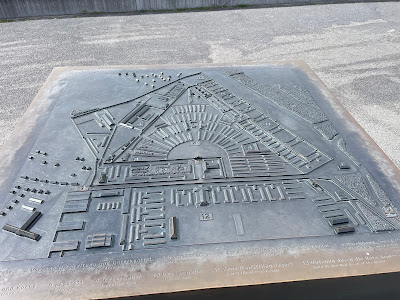Berlin - I had the profound opportunity to visit the Oranienburg Concentration Camp in Sachsenhausen. We took an 1hr train to reach Sachenhausen station and walk about 20 mins to the concentration camp.
 |
| seating on a seat that is not a seat |
 |
| Double decker train |
Located just outside the city, this historical site offers a sobering glimpse into one of the darkest chapters of human history. The experience was both educational and emotionally stirring, providing an invaluable perspective on the atrocities committed during the Nazi regime.
 |
| entrance to the concentration camp |
Upon arriving at the camp, I was struck by the stark contrast between the peaceful surroundings and the grim history of the site. The visitor center provided essential context, offering maps, brochures, and an overview of the camp's history.
 |
| Death march lined the road to the concentration camp |
Oranienburg was one of the first concentration camps established by the Nazis in 1933, initially used for political prisoners. It later became a model for other camps, symbolising the brutality of the regime.
 |
| Layout of the execution of prisoners |
Walking through the camp, I learned about its evolution from a small detention center to a major concentration camp.
 |
| Comandant house |
The entrance to the camp, known as Tower A, is one of the most haunting structures. It was here that prisoners first entered the camp, often facing immediate violence and humiliation. The infamous phrase "Arbeit macht frei" (Work sets you free) inscribed above the gate is a chilling reminder of the false promises made to the prisoners.
 |
| Memorial stone |
 |
| Pax in front of stain glass art |
Our lunch at the cafe - Salami bargette and ham and cheese bargette
Oranienburg held thousands of prisoners, including political dissidents, Jews, Roma, and other marginalized groups.
 |
| Canning bench |
 |
| Inmates uniform |
The camp's layout, with its barbed wire fences and watchtowers, conveyed the oppressive nature of the place. The memorial plaques and informational signs provided detailed accounts of the daily life and suffering endured by the inmates.
 |
| Hanging of inmates |
The punishment cells were particularly harrowing, highlighting the extreme measures taken to break the spirits of the prisoners. Stories of torture, starvation, and medical experiments were vividly recounted, leaving a lasting impact on visitors.
 |
| Crematorium |
 |
| Entrance to the crematorium |
Perhaps the most solemn part of the visit was the execution trench and mass graves area. This site served as a stark reminder of the lives lost and the senseless brutality that occurred. The memorials here were poignant, with wreaths and flowers left by visitors paying their respects.
 |
| Station Z - end of life of the inmate |




































No comments:
Post a Comment